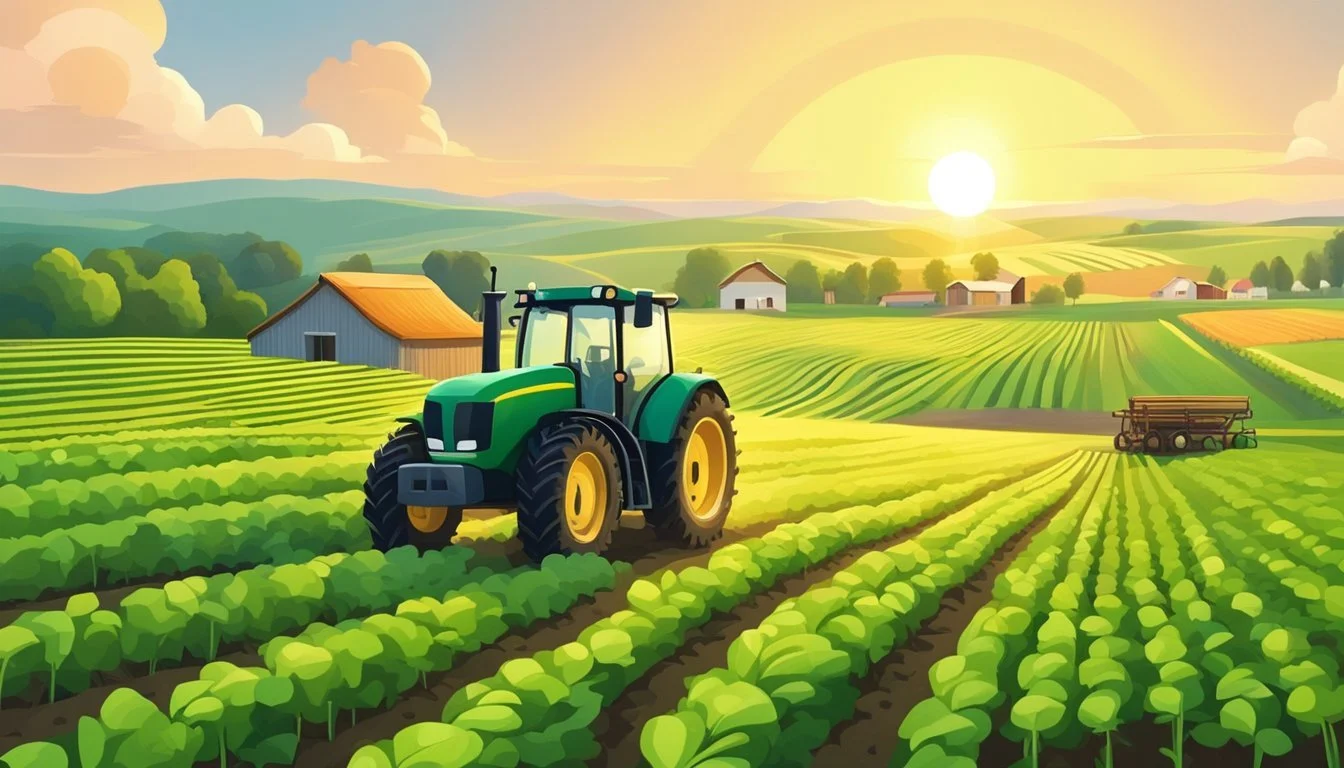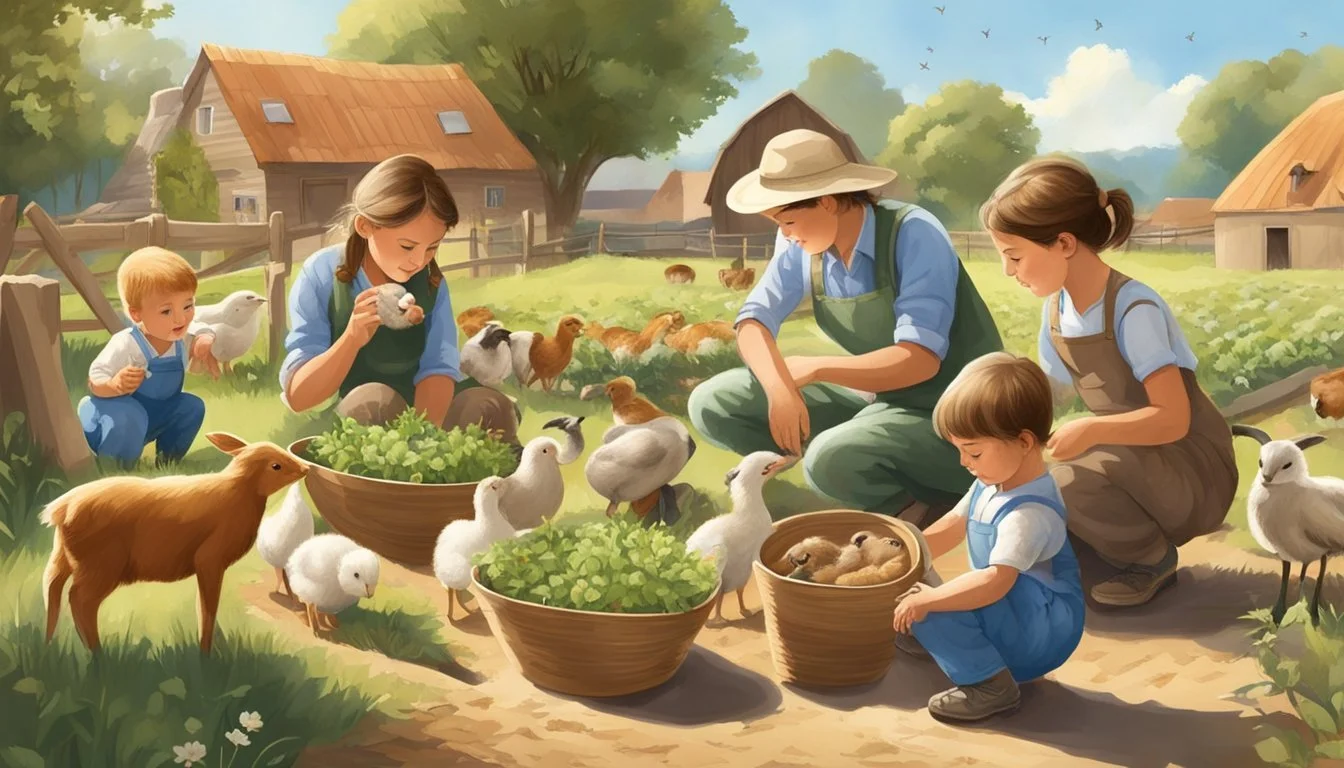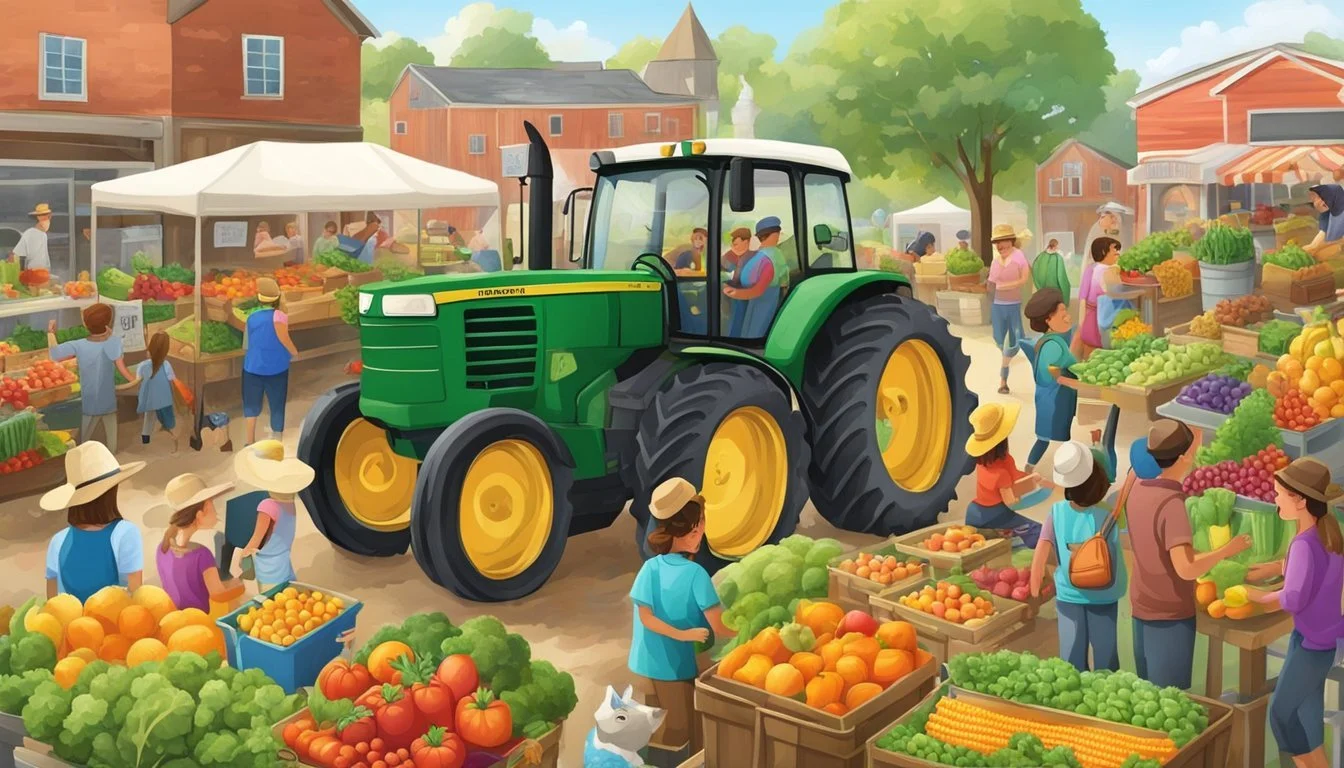Easter and Agriculture
Engaging Activities for Kids to Learn About Farm Life
Easter is a time of renewal and growth, symbolized by the blossoming of flowers and the re-emergence of wildlife. It's also an opportune moment to educate children about the vital role of agriculture in that cycle of new life. Through exploring farm life during this season, kids can gain a deeper appreciation for the origin of their food and the importance of sustainable farming practices. Lessons in agriculture can teach children about the interconnectedness of nature and human activity and the responsibilities involved in stewarding the environment.
By integrating Easter themes with agricultural education, children can learn about farm animals, plant life, and the equipment used in farming through activities that are lively and seasonally themed. Easter egg hunts, for instance, can be adapted to include facts about chickens and egg production, providing context and a real-world connection to farming. Similarly, planting activities can be linked to the Easter theme of rebirth and growth, as children get hands-on experience with seeds, understanding the process from planting to harvest.
This approach not only aligns well with the springtime setting of Easter but also makes the learning process engaging and relatable. As a family-centric holiday, Easter presents an excellent backdrop for farm-based educational activities that can be enjoyed collectively. These shared experiences help reinforce learning through doing, which can leave a lasting impact on young minds about the essentials of agriculture and its significance in their daily lives.
The Significance of Agriculture
Agriculture lays the foundation for the food we consume and is crucial in shaping the understanding of where our food originates. This section explores how farming imparts essential knowledge about food production and its role in our daily sustenance.
Understanding The Basics Of Farming
Agriculture gives insight into the origins of our food. It involves cultivating the soil for the growing of crops and the rearing of animals to provide food, wool, and other products. Organic farms, which avoid or greatly limit synthetic inputs, further offer a perspective on farming that aligns closely with natural processes. People, especially children, benefit from learning about the various aspects of farm life, from planting seeds to animal husbandry. This fundamental knowledge helps demystify the journey from farm to table.
The Role Of Agriculture In Food Production
As the primary source of our food, agriculture is indispensable in food production. Farms of various scales work to supply the population with a wide range of food products.
Large-scale farms often grow vast quantities of a single crop, known as monocultures.
Small-scale and organic farms might focus on diverse crops to maintain ecological balance.
In both cases, the common goal remains to feed the populace. By understanding agriculture's role, individuals can make informed decisions about their food choices, whether they prefer mass-produced commodities or those sourced from local, sustainable operations.
Animal Husbandry
When teaching kids about farm life during Easter, the principles of animal husbandry provide a practical insight into the role and care of farm animals. By understanding both the interaction with different species and their contribution to farming, children can appreciate the importance of livestock.
Getting To Know Farm Animals
Farm animals encompass a variety of species, each with distinct roles and characteristics. For example, pigs are known for their intelligence and ability to adapt to different environmental conditions. A typical dairy farm houses cows, the primary source of milk; children learn how milking works and the process that brings dairy products to the table. Sheep are tended for their wool and meat, with the ewe (female sheep) giving birth to lambs during the spring, providing a live example of reproductive livestock management. Chickens contribute with egg production, whereas ducks offer both eggs and feathers.
Bees play a crucial role in agriculture through the pollination of crops and production of honey.
Small farm animals include rabbits, often raised for their meat and fur.
Horses, though not as common for meat, are integral to many farms for their power, transportation, and companionship.
The Importance Of Livestock To Farming
Livestock are indispensable in farming ecosystems. They provide various resources such as meat, milk, eggs, and materials like leather and wool. Cows, sheep, and goats form the backbone of a productive farm by sustaining the dairy supply and meat provisions. Horses can be utilized for fieldwork, transport, and therapy, exemplifying adaptability. Here, children learn vital lessons about nurturing animals, the lifecycle, and the origins of food and materials:
Children understand that livestock requires careful feeding, health monitoring, and adequate living conditions, which teach responsibility and compassion.
They see the direct connection between animal welfare and the quality and safety of food products.
By engaging with these concepts, children gain a hands-on appreciation of animal husbandry and its central role in agriculture.
Plant Cultivation
In this section, we explore the tangible aspects of agricultural practices focused on plant cultivation, highlighting the processes of growing various crops and the science behind planting and harvesting.
Exploring Various Crops And Vegetables
When educators introduce the concept of plant cultivation to children, it's important to feature a range of crops and vegetables to illustrate the diversity of agriculture. Corn and potatoes are staple crops, offering clear examples due to their ubiquity and the distinctiveness of their growing cycles. Children learn that corn grows from a seed to a tall stalk, producing ears of corn, while potatoes develop underground as tubers.
Vegetables: Common examples include carrots, lettuce, and tomatoes.
Fruit: Examples include strawberries, apples from trees, and grapes from vines.
Fields: The environment where many crops are sown in rows for optimized growth.
Teaching about different vegetables and fruits—especially those grown locally—can help children understand seasonal growth patterns and the importance of diverse agricultural systems.
The Science Of Planting And Harvesting
The success of planting and harvesting relies on understanding the science of growth cycles and the optimal times for planting and reclamation. During the planting phase, one must consider soil composition, climate, and the right depth for sowing seeds.
Planting: Involves soil preparation, seed selection, and timing.
Harvesting: The process of collecting mature crops from the fields.
Timing is critical in harvesting; for example, corn is typically harvested when the kernels are firm and the husks begin to turn brown. In contrast, potatoes are ready when the foliage starts to die back. This knowledge not only connects children to their food sources but also teaches them about the broader implications of timing and care in agriculture.
Educational Farm Activities
Educational farm activities provide children with a tangible connection to the sources of their food while introducing them to life sciences in an engaging and active manner. Incorporating games, lesson plans, and thematic resources, these activities reinforce learning in an interactive environment.
Farm Life As A Learning Theme
Children can explore various aspects of farm life through a themed approach. Utilizing farm craft ideas for preschoolers and farm activities for elementary students, educators can create an immersive learning environment. Lesson plans may include topics such as animal care, the role of crops, and the importance of farming in the community. These themes can be adapted for both homeschool settings and traditional classrooms, offering versatility in education.
Hands-On Experience With Farming Activities
Hands-on activities play a crucial part in teaching children about farm life. Simulating farming tasks, such as planting seeds or tending to a classroom garden, allows kids to experience the gratification of nurturing and observing growth. Farming games and craft projects, like making a barn or animal masks, can help to solidify the understanding of farm operations and animal husbandry in an exciting, playful manner.
Connecting Science And Nature Through Farming
In teaching about farm life, there is an opportunity to connect science and nature. Activities that explore the life cycle of plants, the nutrition of soil, and the habitats of farm animals engage children in the practical application of the sciences and can inspire curiosity and respect for nature. Resources that provide science-based farm activities for kids often include experiments that can be performed in the classroom or at home, effectively blending education with real-world discovery.
Teaching Resources And Materials
When it comes to educating children about Easter and its connection to agriculture and farm life, a variety of teaching resources and materials can be effectively utilized. These include hands-on crafts and games, printable educational tools, and curricula integrations, all designed to deliver comprehensive agricultural lessons in a comprehensible and enjoyable manner.
Crafts And Games To Teach Farm Life
Introducing crafts and games related to farm life allows children to learn through engaging activities. For example, farm animal coloring worksheets and farm dot letter coloring pages offer a creative way for kids to recognize different animals while improving their fine motor skills. Additionally, games that simulate farm activities can instill a basic understanding of farming responsibilities and cycles.
Crafts:
Farm animal puppets (laminate for durability)
Seed art projects
Games:
Virtual farm tours
Interactive farming simulations
Printable Worksheets And Educational Tools
Worksheets play a significant role in reinforcing knowledge learned through crafts and games. They include farm counting cards and puzzles and farm skip counting math worksheets, which are instrumental in building early math skills. Moreover, farm counting mats encourage number sense development. These activity sheets can be laminated to provide a reusable resource for both classrooms and homeschool settings.
Math Resources:
Skip counting and number sense worksheets
Educational Tools:
Farm-themed activity sheets
Farm life cycle explanations
Incorporating Agriculture In Lesson Plans And Curricula
Curricula designers increasingly weave agricultural education into lesson plans. The Curriculum Matrix by the National Agriculture in the Classroom and resources from the American Farm Bureau Foundation for Agriculture provide educators with comprehensive tools. These resources facilitate the integration of agricultural topics—ranging from plant life to farm technology—into diverse subject areas, ensuring that students receive a broadened educational experience.
Educational Integrations:
Agriculture-based science and social studies units
Exploration of sustainable farming practices within environmental studies
Nutrition And Health
In the context of Easter and the agricultural lifestyle, nutrition and health are pivotal. Children's understanding of food origins and the impact of farm-fresh produce on wellness is invaluable.
Understanding The Farm-To-Table Journey
The farm-to-table journey starts at the site of food production and ends on the family's dining table. This process educates children on how food is cultivated, harvested, and delivered. Seeing this first-hand at a local organic farm can instill a deep appreciation for fresh produce and the labor that brings it to their plates. It encourages healthy eating habits by illustrating the direct link between the farm's output and the nutritional rewards they provide.
The Nutritional Value Of Organic Foods
Organic farms adhere to specific regulations that avoid synthetic pesticides and GMOs, which many believe results in higher nutritional content in the food produced. The integration of organic foods into a child's diet can lead to:
Richer nutrient profiles: They may contain higher levels of certain nutrients, such as antioxidants.
Lower levels of pesticides: This is particularly important for children's developing bodies.
The emphasis here is on delivering clear and truthful insights into the nutrition and health benefits that organically produced foods can offer, especially when sourced directly from the farm to the table.
Agriculture And The Environment
Agriculture holds a pivotal role in shaping the environment, often serving as a steward through practices that can be either beneficial or detrimental to ecosystems and biodiversity.
Sustainable Farming Practices
Sustainable farming practices are essential in cultivating an environment that supports health and vitality. Farmers are increasingly adopting methods such as crop rotation, cover cropping, and conservation tillage to enhance soil health and reduce erosion. The integration of organic farming practices minimizes the use of synthetic fertilizers and pesticides, thereby protecting water quality and promoting a safer environment.
Crop Rotation: This involves alternating the types of crops grown in a specific area across seasons or years. It helps in preserving soil nutrients and preventing soil-borne diseases.
Cover Cropping: Non-commercial plants are grown to protect and enrich the soil.
Conservation Tillage: Reducing tillage preserves soil structure, prevents erosion, and can improve water retention.
These strategies contribute to sustainability, ensuring that land remains fertile and productive for future generations.
The Role Of Farms In Ecosystems And Biodiversity
Farms play a crucial role in maintaining ecosystems and fostering biodiversity. Local farms often serve as habitats for various species and are integral to conservation efforts. They offer trees and plants that enable pollination; an activity vital to the survival of many crops and wild plants, largely performed by bees and other insects. Organic farms especially, which avoid harmful chemicals, can support a richer diversity of life, from microorganisms in the soil to bird populations above. Maintaining a diverse array of species on farms can lead to more resilient agricultural systems and ecosystems.
Cultural And Seasonal Events
In the context of teaching children about farm life, cultural and seasonal events such as Easter present unique opportunities. These events often include farm-related activities that educate and entertain simultaneously.
Easter Traditions And Farm Life
Easter is intrinsically linked to the symbols of new life and renewal, which are integral to farming culture. During Easter, local farms frequently host egg hunts, which serve not only as entertainment but also as an avenue for children to learn about poultry and egg production. This connection between holiday festivities and agricultural education provides a platform for demonstrating the cycle of life on a farm through direct experience with farm animals and crops during a significant cultural event.
Egg Gathering: Invites children to partake in the hands-on experience of collecting eggs, introducing them to the concept of where their food comes from.
Animal Feeding Stations: Allow youngsters to interact with baby animals typically born during the spring, fostering an understanding of animal husbandry.
Special Events And Agriculture Education
Beyond Easter, farms often organize special events that aim to deepen the appreciation and knowledge of food production and rural life. Agriculture education is a focal point during these gatherings, where children can engage firsthand in planting seeds or learning about the origins of their meals.
Interactive Workshops: Practical sessions such as cheese making or bread baking that illustrate the journey from raw ingredients to finished products.
Farm Tours and Demonstrations: Guided explorations of local farms that showcase different agricultural practices and machinery in action.
Both Easter and other agricultural-focused events offer insightful, hands-on learning experiences. They not only highlight the importance of farming in daily life but also stress responsible stewardship of the environment to the younger generation.
Skills And Values From Farm Life
Engaging with farm life exposes individuals, especially children, to inherent agricultural values and skills. These experiences cultivate a unique set of attributes beneficial throughout life.
Hard Work And Dedication In Agricultural Practices
Farm life ingrains a strong ethic of hard work and dedication, especially noticeable in the daily responsibilities of tending to crops and livestock. It requires a steadfast commitment, as the operation of a farm does not pause for adverse weather or personal convenience. This dedication is observed in all age groups involved, teaching them that consistent effort is essential for success.
Early Rising: Children often learn to wake up early to feed animals or water plants, instilling discipline.
Regular Chores: The operation of a farm hinges on the timely completion of daily tasks, underscoring the importance of hard work.
Teamwork And Communication On The Farm
Teamwork is another cornerstone of farm life, with each individual's effort contributing to a larger goal. Coordination and clear communication are vital in managing a farm's daily operations successfully.
Collaborative Tasks: Whether it's harvesting or repairing fences, tasks on the farm often require collective effort.
Information Sharing: Open and regular communication ensures that everyone is informed about the tasks at hand and that the operation runs smoothly.
The experiences provided by farm life build skills and values that are carried into many other areas of life.
Supporting Local Agriculture
Local agriculture forms the backbone of sustainable food production, and its promotion can be powerfully impactful when coupled with educational initiatives aimed at children.
The Importance Of Local Farming Communities
Local farms are the pillars of their communities, fostering sustainability and resilience in food production. They often employ environmentally friendly practices that minimize waste and conserve resources. By supporting local farming communities, consumers can help maintain the biodiversity of crops and livestock, contribute to the local economy, and ensure a shorter farm-to-table journey, reducing carbon footprints. Educating children on the critical role these farms play in their daily lives instills appreciation and a sense of responsibility towards their local ecosystems.
Economic Benefits: Local farms contribute significantly to the local economy, creating jobs and sustaining livelihoods.
Environmental Impact: Sustainable practices adopted by many local farms reduce ecological footprints.
Health Advantages: Fresh, seasonal produce from local farms is often more nutritious than produce that has traveled long distances.
Educational Farm Visits And Virtual Field Trips
Actual visits to farms and virtual field trips offer invaluable, hands-on learning opportunities for children to see where their food comes from and understand the effort behind its production. Such experiences can demystify agricultural processes and highlight the importance of farming in everyday life.
Educational Farm Visits:
Personal Interactions: Interacting with farmers allows students to learn firsthand about daily farming life and the challenges involved.
Hands-On Learning: Activities like planting seeds or feeding livestock help solidify the children’s connection with agriculture.
Virtual Field Trips:
Accessibility: For schools that cannot access a local farm easily, virtual trips provide a convenient alternative.
Broad Reach: These trips can show a variety of farming types and practices that may not be locally available, providing a broader understanding of agriculture.
By engaging children in supporting local farming through direct experiences and virtual explorations, they are empowered to become informed consumers and advocates for sustainable food production practices.











